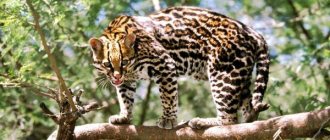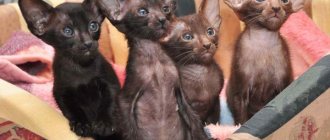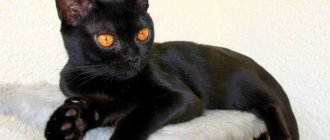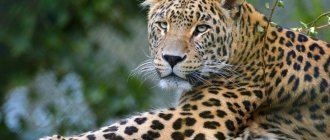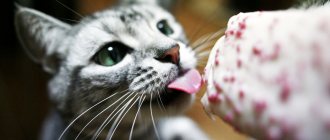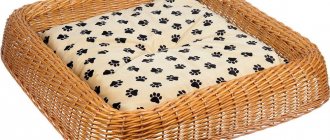The ocelot is a wild cat whose appearance is literally breathtaking. The fur is very delicate, which is the reason why people hunt the big cat. His defense became his biggest threat. The ocelot is recognized as the most beautiful cat in the world. This predator can only be found in zoos, because it lives in America in natural conditions. Unfortunately, this species is endangered due to poachers. Currently, animals are protected by law.
The ocelot (Leopardus pardalis) is a species of carnivorous mammal of the cat family, and is more than twice the size of a domestic cat!
Ocelot – where does the name come from?
The name "ocelot" appears in many languages. Among the Nahua Indians, the word ocelotl means "jaguar". Translated from Greek laopardos means "jaguar".
Ocelot, otherwise called a dwarf leopard, because of its similarity, only much shorter in stature. However, it is worth adding that he is not related to any of these cats: tiger, leopard and jaguar. Interestingly, the ocelot is the second largest spotted cat in South America, next to the jaguar!
The cat has very developed maternal instincts. They attach great importance to building a proper, cozy and safe nest for babies. Females even tear out their fur from the skin on their bellies to make it easier for their kittens to suckle. They teach kids how to hunt properly. Unfortunately, the situation is somewhat worse with ocelot fathers.
It is difficult to find a mate for these animals. Ocelots are solitary, and each of them occupies large territories (one territory is up to 90 sq. km!). If a couple manages to find each other, they mate even 10 times a day, which does not give confidence in pregnancy. Moreover, males show aggression towards females. This happens because the natural enemies of the ocelot are not only jaguars and pumas, but also other ocelots!
Ocelot - what it looks like and what you should know about it Appearance:
The coat is smooth and silky. The color depends on the environment in which the cat lives. Cats that live in forests have yellow or red fur, while those living in bushes have gray fur, so that they are not noticed by other predators. There are three or four rows of dots on the sides of the body. Each fur pattern is absolutely unique as a snowflake! No two cats are alike. On the back and sides the spots form rosettes, and on the head, paws and tail they turn into dark stripes. The belly is light and the ears are black with white spots.
The tail is not long, decorated with beautiful, dark rings. The physique and thick limbs are completed with sharp claws. And despite its light weight, the cat looks strong and formidable.
Ocelot dimensions: Body length: 38 – 100 cm
Tail length: 20 – 52 cm
Weight: from 7 – 16 kg. Males are naturally larger and heavier than females.
Lifestyle:
Cats are solitary and do not pair up. They lead a strictly nocturnal lifestyle. They spend the day at altitude, in trees, and hunt at night. They are excellent swimmers, unlike domestic cats. Their hearing and sense of smell are acute, thanks to which they have proven themselves excellent in hunting. Feels good in tropical forests, bushes and savannas. It can live even at an altitude of 4 km above sea level. They often live close to human habitations. Also found in sugar cane fields and plantations.
What do ocelots eat? The main source of food is meat. They eat monkeys, armadillos, anteaters, rats, lizards, snakes, turtles, birds and fish. Ocelots bury uneaten food. This is a typical predator. Catches prey every 3 hours during one hunt. Quite picky. Removes feathers from the victim and gets rid of fur.
How long does an ocelot live ? In the wild, unfortunately, they live half as long as in captivity, only 10 years. In nature reserves and zoos, 20 years of age can be reached without any problems.
Reproduction:
Reproduction is a rather difficult task for animals, since females mature sexually at the age of two years, but are ready for offspring only at 4 years of age, which is almost half of their life.
Males, in turn, mature at 2.5 years.
Pregnancy lasts from 72 to 82 days.
Each female has only two pairs of nipples (for comparison, a domestic cat has four pairs), which makes it impossible to have more offspring. There are 1-2 kittens in the litter.
Baby ocelots open their eyes at about two weeks of age. They are born very small but develop quickly. They begin to walk at three weeks and receive constant food at the age of eight. Capable of independent living only after 12 months. They remain in the nest with their mother even after two years.
Defense: Unfortunately, the situation looks bad. 200 thousand individuals per year are killed for their fur. The young are taken from the nests to be sold for home breeding. Another threat is progressive environmental change; however, cats appear to have great adaptive capacity.
However, despite the fact that trade in their skins is prohibited. These animals are still being killed. It is believed that the coat with fur costs 40 thousand dollars. Fortunately, advocacy organizations are doing more. and more efforts to stop this barbaric business plan.
As for the current number of these wild cats, it depends on the region. For example, in Texas there are 80 individuals, in Brazil there are currently 800,000 to 1.5 million.
The predator also stands out from other cats by the sounds it makes. Did you know that ocelots don't purr? Their signature sound... Giggle! A cat giggles when he's excited. However, kittens can purr. They do this towards other cats, and when they are injured or sick. The vibration of cats is so low that it has healing properties.
Domestic ocelot
Ocelots are bred in captivity. Domestic ocelot is the name of the domestic cat that was created by crossing the Abyssinian, Siamese and American Shorthair.
How much does an ocelot cost ? The price of a big cat abroad ranges from 1,500 to 20,000 dollars.
photo source
Facts about big cats - ocelots
Raising offspring is important for females. Kittens are taught hunting techniques for 2 years to prepare them for adult life.
Animals stand out among other cats for their ability to swim.
Ocelots are highly protective of their territory. Often fights go to the death.
Despite the fact that there is a ban on killing these animals, poachers still hunt for commercial purposes.
These animals are often found as pets. The famous Salvador Dali had an ocelot as a pet.
Big cats are solitary, meeting only during mating.
These are nocturnal animals. At night they go hunting, and during the daytime they rest in the treetops.
Cats sleep in a dog-like position. They are the only felines that curl up into a ball and rest their head on their hind legs during sleep.
Poachers not only kill these animals, but also steal kittens from the nest. Some of these animals are kept at home as pets.
Interesting for you;
History of study, subspecies
Various species of Ocelots are common on the mainland of the Western Hemisphere. The predatory mammal, called Leopardus Pardalis, was first discovered in the 18th century. and described by Carl Linnaeus. During the 19th and 20th centuries, subspecies mitis, gouazou, pseudopardalis and others were found in Argentina, Mexico, Colombia and other countries in South and Central America, as well as the North American state of Texas. Representatives of different subspecies are similar to each other in size and body structure, with minor differences in the patterns on the coat.
Photo – Ocelot
Varieties
If you want to keep a pet at home that looks like an ocelot and has the same size, lovers of exotic cat breeds are advised to take a closer look at Asher cats. She is rightfully a rival of ocelots, caracals and fennec cats. Asher is a cross between a serval and a regular domestic cat. Has highly developed intelligence and communication skills. The animal is sociable, gets along well with children, and easily lives with other pets. But if you don’t give your cat the proper attention, it will quickly turn from tame to wild. Therefore, the cub must be immediately accustomed to socialization.
Depending on their habitat, the following subspecies are distinguished:
One of the subspecies of the animal is the Brazilian.
- Texan;
- Nicaraguan;
- Brazilian;
- leopardus pardalis pardalis;
- leopardus pardalis nelsoni.
General characteristics, habitat zones
Where does he live? Ocelots are medium-sized wild cats that live in the southwestern United States, Mexico, South America, and Central America. Predators are listed in the Red Book, but do not belong to endangered species, since the number of these animals is about 40 thousand individuals and does not show a tendency to decrease on a global scale.
In past centuries, these cats were considered a valuable hunting trophy due to their beautiful fur, mottled with black markings of varying widths.
Most likely, the name of the animal comes from the Indian dialect. There is a version that the name is etymologically related to the word “cellatus”, which in Latin means “with eyes” and contains a hint of the spotted color of the cat’s skin. Residents of various areas give wild tabby cats their own folk names, indicating their resemblance to tigers or jaguars (tigrecillo, tigrillo, jaguatrica, gato tigre).
Genetic studies indicate that Ocelots have existed as a distinct species for over a million years. Close relatives are the following representatives of the cat family:
- Oncilla;
- Andean;
- Geoffroy;
- Margay;
- Guinha;
- Pampasskaya.
What does it look like? Representatives of the species are characterized by an athletic build with elongated legs. The size of the body together with the head ranges from 60 cm to a meter, the tail is not too long - up to 0.4 m. The weight of an adult female is 6.5-11.5 kg, a male is 7-15.5 kg.
The fur color of the animals is an impressive interweaving of coal-black geometric lines of varying thickness and size. Several long stripes are located along the spine along the entire length of the back, right down to the end of the tail. The background of the fur is painted in grayish-brown or beige-red colors of varying degrees of saturation. The lower part of the body is light. The length of the hairline is up to a centimeter.
The shape of the ears is round. The tip of the large nose is pink or brick colored. Eye color – brown.
Although Ocelot is similar to Margay, it differs in twice the mass and has a shortened tail. The size of the animal is closer to that of a lynx. The largest cats can be confused with young jaguars, but the striped color gives the predator away.
Predators live in various climatic zones: savannas, tropical jungles, mangrove swamps. Habitats rise to a height of up to 3 km above sea level. Animals prefer to settle in areas with dense vegetation; during daylight hours they try to stay away from open areas. In the United States, these representatives of the cat family live in National Parks or private property. There are cases of registration of individual individuals outside protected areas, but generally the animals try to stay away from people. In Mexico, predators live in pine thickets at an altitude of 2 km above sea level.
Appearance
The animal ocelot is several times larger than an ordinary cat, and looks like a leopard. Has a stocky constitution:
- Muscular body.
- A large, heavy head with slanting big eyes.
- Short neck and tail.
- Powerful paws (hind legs are longer than front ones).
- The length of the body with tail does not exceed one and a half meters.
- The weight of an adult animal is 10–16 kg, height at the withers is 50 cm. Males are about a third larger than females.
- The color of ocelots is individual, each of them has a unique pattern on its fur.
- The fur is short, thick, velvety, golden brown on the back and paws, white on the belly and chin. The body is covered with ring-shaped black spots, turning into stripes on the neck and shoulder area. The black ears are marked at the back with a characteristic white dot.
Behavior
These representatives of wild cats tend to lead a solitary lifestyle, going out hunting in the dark. Like most of their relatives, cats live and hunt in certain areas, the boundaries of which are marked with secretions and notches on trees and zealously fight against intruders. The size of the male's possessions ranges from 2 to 46 square meters. km, females – 1-15 sq. km. At the same time, males freely enter the territory of females.
Outside of marital relations, communication between animals is reduced to a minimum, with rare exceptions. Babies stay with their parents for a long time.
Thanks to camouflage coloring and caution, Ocelots manage to avoid the attention of people and other representatives of the animal world. Modern means of observation have made it possible to clarify data regarding the lifestyle of these secretive animals. During the daytime, predators lie down under the protection of trees or bushes and begin hunting before dawn. Active actions last up to 12 hours. The speed of cats in hunting mode is 0.3 km per hour, when walking around the boundaries of the site it is 5 times faster.
Studying the video recordings revealed that cats of this species prefer to arrange toilets for public use, which indicates a greater degree of social interaction than previously thought.
The living density of seals depends on natural conditions: the presence of dangerous predators, the frequency of precipitation, and the food supply. The number of individuals living in an area of one hundred square kilometers can vary from 2-3 to 50-60 individuals.
Biologists have concluded that representatives of the species prefer wet areas rather than dry ones. A unique feature of these cats is their love for the water element. Predators can move along water streams over long distances. The animals easily travel over rough terrain, jump over rocks and boulders, and move along tree branches, but they still prefer to settle in flat areas.
Seals can make various sounds, except for a lion's roar. During sexual hunting, animals meow.
Natural enemies of Ocelots are pumas, jaguars, pythons, caimans and other large predators. For many years, the extermination of furry beauties was carried out by people attracted by the unique patterns on the skin.
Ocelot conservation
Back in the 70s of the last century, ocelots appeared in the International Red Book, which was the result of vigorous hunting activity that led the animals to the brink of complete extinction. After this, a strict ban was imposed on hunting and trading in ocelot skins. In addition to all kinds of prohibitions, people began to create various protected areas and national parks, where predators began to breed without such threats from the outside.
The presence of such measures made it possible to change the conservation status of the animal and since 2008 these animals are considered a species “at least under threat.” Despite such efforts, the number of the animal is constantly decreasing, since poachers have not gone away, and people are destroying natural habitats.
The problem is that humans are uncontrollably cutting down tropical forests, which are home to many animals, including ocelots. In addition, deforestation leads to the disappearance of many other animal species that are part of the diet of these predators. In other words, everything in nature is interconnected and humans should not violate these natural connections.
ATTACK OF OCELOT / Coyote Peterson in Russian
Nutrition
In nature, the hunting objects of these predatory mammals are small animals, birds, fish and amphibians. Of the representatives of South American fauna, the most common animals that cats eat for lunch are rodents, armadillos, and even large insects. Brazilian representatives of the species feed on small monkeys, while Mexican representatives feed on iguanas. The main criterion when choosing prey is weight and size. Typically, animals are content with prey weighing up to 1 kg, especially since this is the amount of food a cat needs to meet its daily need for proteins and fats.
In many ways, the diet depends on the time of year. For example, during periods of drought, Venezuelan cats eat rodents and lizards, and when there is heavy rainfall, they eat land crabs.
In general, the tastes of Ocelots are not too different from the eating habits of representatives of related species of the cat family. Oncillas usually choose birds and arboreal marsupials, and Margay is not particularly picky in its choice of food.
Developed senses help seals find prey: a keen sense of smell, night vision, and acute hearing. The predator lies in ambush not far from the prey and waits for the prey to lose its vigilance. If the object of the hunt manages to escape, the hunter changes his location. The cat kills a caught animal or bird by tearing its throat with its teeth and immediately eats it, biting off large pieces. The predator pre-plucks the feathered prey.
If it is impossible to profit from game or meat, the cat goes to the nearest body of water to search for fish or reptiles.
Feeding
Adult domestic ocelots eat almost the same food as in the wild. The basis of the diet is raw meat - game, beef, chicken, feed mice. Periodically, the diet is expanded with raw eggs, fish, and high-quality cat food. It is forbidden to feed raw pork meat (causes Aujeszky's disease) . Until the age of three, ocelots receive calcium supplements and vitamins.
Feeding regimen: one or two feedings per day according to the established schedule. Food should be at room temperature, daily volume – 300 – 500 grams (depending on the weight of the animal). Remains of food and meat must be removed.
Reproduction
Mating calls, which allow males and females to find each other during sexual hunting, are similar to ordinary meowing, only greatly amplified. Such screams can be heard over long distances. Ocelots mate throughout the year. The time of maximum sexual activity depends on the region of residence. Thus, animals living in Paraguay and Argentina more often look for a sexual partner in the fall, and residents of Mexico and the state of Texas - in the fall and winter. Estrus in females lasts from three days to a week. If pregnancy does not occur, the female is ready for mating again after 4 weeks.
Biological studies have shown that in wild small cats living in Brazil, maximum sperm production is achieved during the summer months. Having found a suitable female, the male spends several days with his chosen one, without being separated even for hunting and eating. During these days, the couple communicates intensively, constantly sniffing and caressing.
A mother cat usually gives birth to one to three kittens. Pregnancy lasts 77-85 days. To care for the offspring, the mother prepares in advance a comfortable nest, securely hidden among dense thickets. The weight of a newborn kitten is about 300 g. Observations carried out in Texas showed that as mothers grow older, they move their cubs to new places.
For the first two weeks of life, babies remain blind, then the kittens' eyes open. The cubs leave the shelter for the first time when they reach the age of 12 weeks. Adolescents begin to lead an independent life after the age of two, and until then remain under maternal supervision. At 2 years old, young cats can already search for prey without the help of adults and defend their own hunting grounds.
When comparing Ocelots with other felines, biologists note a larger gap between births and a small number of cubs in one litter.
In nature, representatives of the species live 15-20 years, in captivity they can live up to 30 years. Females reach the ability to mate by one and a half years, males - six months later. Another distinctive feature of representatives of the species is the care that males show towards members of their family. The cat does not leave his wife while bearing offspring, and then takes care of the children, protecting them from danger and obtaining food.
Interesting Facts
A famous representative of this breed is a cat named Babou, who was a favorite of Salvador Dali. Dali and the ocelot traveled all over the world together. The animal was a reliable and faithful companion to its owner, for which he loved it unquestioningly. Another interesting fact is that the cat is very brave and fearless. Protecting herself and her offspring, she can attack a 2-meter boa constrictor. Ocelot was worshiped by the ancient Egyptians. It was customary to make various figurines and decorations in the image of the animal.
Captivity
Ocelots are well domesticated, although they retain elements of behavior characteristic of wild animals. Even a tamed animal will continue to be wary and tense when communicating. At the same time, a high intellectual level allows these pets to learn the basic rules of behavior: using a litter box, diet, obedient behavior. Animals maintain the cleanliness inherent in all cats, maintaining their fur in perfect condition.
However, living in a small apartment is contraindicated for these pets. Animals need space to be active, including climbing trees and swimming. Limiting a cat's living space will lead to illness and even death. The ideal habitat for the fluffy beauty will be a spacious enclosure on a personal plot, with a pond, equipped with devices that allow you to spend time at height (tree trunks, ladders, etc.).
The owner should be prepared for the animal to mark its territory, since this behavior provides the animal with a sense of security. This even applies to sterilized pets. In addition, when deciding on castration, you should remember that wild cats do not tolerate anesthesia well and the decision on surgical intervention should be made after consultation with a veterinarian.
With proper care and comfortable conditions, wild cats can live up to 30 years in captivity and even give birth.
Kittens are taken from breeders when they reach the age of 3-4 months, when the first vaccinations have already been done. Subsequently, animals must undergo regular treatment with anthelmintic and insecticidal drugs, and be vaccinated annually against panleukopenia, calcivirosis, rabies, chlamydia, and rhinotracheitis.
A kitten raised in the company of people will be quite tame and calm. However, upon reaching adulthood, the pet should be placed in an enclosure to create a comfortable living environment for the pet.
Ocelots have developed instincts of hunting and competition, so the animal is usually not inclined to make friends with other pets. Animals have a playful nature, so to entertain your pet, you need to buy durable toys designed for large dogs.
Representatives of this species do not tolerate shouting, perceiving a raised voice as a sign of aggression and retaining resentment for a long time. If the baby begins to behave aggressively, the kitten should be left alone indoors, then the pet will gradually calm down and come to its senses.
For young children, wild cats pose a danger because they are not used to restraining their strength during play.
A wild cat's diet should consist of raw meat without fat, poultry, and sometimes live mice. Nutritional supplements designed for domestic cats are not suitable for your pet.
Ocelots, as one of the most graceful representatives of the animal world, are represented in most of the world's zoos, as well as in national parks and reserves.
Character traits
The ocelot is brought up in a playful way from childhood, showing intelligence and intelligence. Its habits resemble a cat and a dog at the same time. Loves to play with a ball and bring it to its owner. Walks on a leash, jumps and climbs trees, and swims in the pool. The animal is curious and studies new toys with interest. She is well accustomed to the litter box, but does not bury excrement.
Friendship with other animals is an extremely rare case, but it is still possible if a small kitten ends up in a house where there are already pets and grows up with them.
How to buy an Ocelote kitten
What is the price? The price for representatives of the species remains high ($15-20 thousand). Providing adequate living conditions for your pet is also not easy. Purchasing wild animals is allowed only in special nurseries that provide correctly completed documents. In the absence of the necessary documents, the predator is confiscated by government organizations, and the buyer is subject to administrative punishment.
